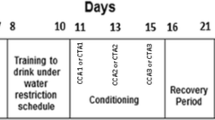Abstract
Rationale
Previous work has shown that some mouse strains (e.g., DBA/2J [D2]) readily develop robust ethanol-induced conditioned place preference (CPP) while others (e.g., C57BL/6J [B6]) do not. Though commonly interpreted as a difference between strains in sensitivity to ethanol reward, other explanations for this finding are possible.
Objectives
To explore the hypothesis that variation in sensitivity to contextual cues underlies CPP differences, the present work investigated ethanol-induced CPP in D2 and B6 mice trained with a standard tactile (floor) cue procedure compared to mice trained with tactile plus visual-spatial cues.
Methods
In an unbiased CPP procedure, mice were assigned to either a single element cue (one-compartment apparatus with tactile cue presented in the dark) or multi-modal cues (two-compartment apparatus with distinct tactile floors and lights on). To track CPP development, mice received preference tests during training in addition to a final test.
Results
Adding visual-spatial cues accelerated CPP acquisition in both D2 and B6 mice. However, this enhancement was observed after just one ethanol-conditioning trial in D2 mice, but was observed only after four ethanol-conditioning trials in B6 mice. Differences between groups trained with single or multi-modal cues disappeared as conditioning reached asymptote, with D2 mice showing a more rapid loss of the effect and a higher maximum CPP.
Conclusions
Although multi-modal cues produce more rapid conditioning, their inability to reduce or eliminate strain differences in CPP supports the interpretation that these strains differ in their sensitivity to ethanol reward.




Similar content being viewed by others
References
Barr GA, Paredes W, Bridger WH (1985) Place conditioning with morphine and phencyclidine: dose dependent effects. Life Sci 36:363–368
Carr GD, Fibiger HC, Phillips AG (1989) Conditioned place preference as a measure of drug reward. In: Liebman JM, Cooper SJ (eds) The neuropharmacological basis of reward. Clarendon, Oxford, pp 264–319
Cunningham CL (1995) Localization of genes influencing ethanol-induced conditioned place preference and locomotor activity in BXD recombinant inbred mice. Psychopharm 120:28–41
Cunningham CL (2014) Genetic relationship between ethanol-induced conditioned place preference and other ethanol phenotypes in 15 inbred mouse strains. Behav Neurosci 128:430–445. https://doi.org/10.1037/a0036459
Cunningham CL, Ferree NK, Howard MA (2003) Apparatus bias and place conditioning with ethanol in mice. Psychopharm 170:409–422. https://doi.org/10.1007/s00213-003-1559-y
Cunningham CL, Gremel CM, Groblewski PA (2006a) Drug-induced conditioned place preference and aversion in mice. Nat Protoc 1:1662–1670. https://doi.org/10.1038/nprot.2006.279
Cunningham CL, Groblewski PA, Voorhees CM (2011) Place conditioning. In: Olmstead MC (ed) Animal models of drug addiction, Neuromethods, vol 53. Humana Press, New York, pp 167–189. https://doi.org/10.1007/978-1-60761-934-5_6
Cunningham CL, Niehus DR, Malott DH, Prather LK (1992) Genetic differences in the rewarding and activating effects of morphine and ethanol. Psychopharm 107:385–393
Cunningham CL, Patel P, Milner L (2006b) Spatial location is critical for conditioning place preference with visual but not tactile stimuli. Behav Neurosci 120:1115–1132. https://doi.org/10.1037/0735-7044.120.5.1115
Cunningham CL, Prather LK (1992) Conditioning trial duration affects ethanol-induced conditioned place preference in mice. Anim Learn Behav 20:187–194
Cunningham CL, Shields CN (2018) Effects of sex on ethanol conditioned place preference, activity and variability in C57BL/6J and DBA/2J mice. Pharmacol Biochem Behav 173:84–89. https://doi.org/10.1016/j.pbb.2018.07.008
Cunningham CL, Zerizef CL (2014) Effects of combining tactile with visual and spatial cues in conditioned place preference. Pharmacol Biochem Behav 124:443–450. https://doi.org/10.1016/j.pbb.2014.07.012
Gabriel KI, Cunningham CL (2008) Effects of maternal strain on ethanol responses in reciprocal F1 C57BL/6J and DBA/2J hybrid mice. Genes Brain Behav 7:276–287. https://doi.org/10.1111/j.1601-183X.2007.00349.x
Gremel CM, Cunningham CL (2007) Role of test activity in ethanol-induced disruption of place preference expression in mice. Psychopharm 191:195–202. https://doi.org/10.1007/s00213-006-0651-5
Hitchcock LN, Cunningham CL, Lattal KM (2014) Cue configuration effects in acquisition and extinction of a cocaine-induced place preference. Behav Neurosci 128:217–227. https://doi.org/10.1037/a0036287
Mucha RF, van der Kooy D, O'Shaughnessy M, Bucenieks P (1982) Drug reinforcement studied by the use of place conditioning in rat. Brain Res 243:91–105
Nagy ZM, Forrest EJ (1970) Open-field behavior of C3H mice: effect of size and illumination of field. Psychon Sci 20:19–21. https://doi.org/10.3758/BF03335578
Rescorla RA, Wagner AR (1972) A theory of Pavlovian conditioning: variations in the effectiveness of reinforcement and nonreinforcement. In: Black AH, Prokasy WF (eds) Classical conditioning II: current research and theory. Appleton-Century-Crofts, New York, pp 64–99
Vezina P, Stewart J (1987a) Conditioned locomotion and place preference elicited by tactile cues paired exclusively with morphine in an open field. Psychopharm 91:375–380
Vezina P, Stewart J (1987b) Morphine conditioned place preference and locomotion: the effect of confinement during training. Psychopharm 93:257–260
Funding
Research reported in this paper was supported by the National Institute on Alcohol Abuse and Alcoholism of the National Institutes of Health under award number R01AA007702.
Author information
Authors and Affiliations
Corresponding author
Ethics declarations
Conflict of interest
The content is solely the responsibility of the authors and does not necessarily represent the official views of the National Institutes of Health. On behalf of all authors, the corresponding author states that there is no conflict of interest.
Electronic supplementary material
ESM 1
(PDF 1091 kb)
Rights and permissions
About this article
Cite this article
Cunningham, C.L., Shields, C.N. Effects of multi-modal cues on conditioned place preference in C57BL/6J and DBA/2J mice. Psychopharmacology 235, 3535–3543 (2018). https://doi.org/10.1007/s00213-018-5078-2
Received:
Accepted:
Published:
Issue Date:
DOI: https://doi.org/10.1007/s00213-018-5078-2




